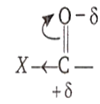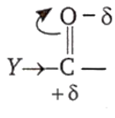 Multiple Choice Questions
Multiple Choice QuestionsWhen AgCl is treated with KCN
Ag is precipitated
a complex ion is formed
double decomposition takes place
no reaction takes place
Which one of the following compounds is most reactive towards nucleophilic addition?
CH3CHO
PhCOCH3
PhCOPh
CH3COCH3
A.
CH3CHO
Carbonyl compounds undergoes nucleophilic addition reaction.

[X- shows negative inductive effect]
If group or atom attached with carbonyl carbon shows negative inductive effect, then it decreases electron density on carbonyl carbon and facilitate the attack of nucleophiles, hence reactivity of carbonyl compound increases.

[Y- shows negative inductive effect]
If group or atom attached with carbonyl carbon shows positive inductive effect, then it increases electron density on carbonyl carbon and supress the attack of nucleophiles, hence, reactivity of carbonyl compound decreases.
The aromatic aldehydes and ketones are less reactive than their aliphatic analogues. This is due to the +R effect of benzene ring.
On the basis of above informations, the increasing order of the nucleophilic addition reaction in the following compound will be CH3CHO > CH3COCH3 > PhCOCH3 > PhCOPh
Which reaction is used for the preparation of acetophenone ?
Reimer-Tiemann reaction
Wurtz-Fittig reaction
Friedel-Craft's reaction
Cannizaro's reaction
Pure methane can be produced by
Wurtz reaction
Kolbe's electrolytic method
soda lime decarboxylation
reduction with H2
